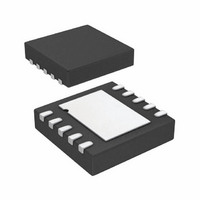AD7156BCPZ-REEL7 Analog Devices Inc, AD7156BCPZ-REEL7 Datasheet - Page 13

AD7156BCPZ-REEL7
Manufacturer Part Number
AD7156BCPZ-REEL7
Description
IC CDC 2CH 12BIT 1.8V 10LFCSP
Manufacturer
Analog Devices Inc
Type
Capacitance-to-Digital Converterr
Datasheet
1.AD7156BCPZ-REEL7.pdf
(28 pages)
Specifications of AD7156BCPZ-REEL7
Resolution (bits)
12 b
Data Interface
Serial
Sampling Rate (per Second)
100k
Voltage Supply Source
Single Supply
Voltage - Supply
1.8 V ~ 3.6 V
Operating Temperature
-40°C ~ 85°C
Mounting Type
Surface Mount
Package / Case
10-LFCSP
Sampling Rate
100SPS
Input Channel Type
Single Ended
Supply Voltage Range - Analog
1.8V To 3.6V
Supply Current
70µA
Lead Free Status / RoHS Status
Lead free / RoHS Compliant
Lead Free Status / RoHS Status
Lead free / RoHS Compliant, Lead free / RoHS Compliant
Other names
AD7156BCPZ-REEL7TR
DATA AVERAGE
The adaptive threshold algorithm is based on an average calculated
from the previous CDC output data, using the following equation:
where:
Average(N) is the new average value.
Average(N − 1) is the average value from the previous cycle.
Data(N) is the latest complete CDC conversion result.
ThrSettling is a parameter, programmable in the setup registers.
A more specific case of the input capacitance waveform is a step
change. The response of the average to an input capacitance step
change (more exactly, response to a step change in the CDC output
data) is an exponential settling curve, which can be characterized
by the following equation:
where:
Average(N) is the value of average N complete CDC conversion
cycles after a step change on the input.
Average(0) is the value before the step change.
TimeConst = 2
ThrSettling is a parameter, programmable in the setup registers.
See Figure 31 and the Register Descriptions section for further
information.
HYSTERESIS
In adaptive threshold mode, the comparator features hysteresis.
The hysteresis is fixed to ¼ of the threshold sensitivity and can
be programmed on or off. The comparator does not have hyster-
esis in the fixed threshold mode.
Average
INPUT CAPACITANCE
(CDC DATA) CHANGE
Average
DATA AVERAGE
(
THRESHOLD
Figure 31. Data Average Response to Data Step Change
N
POSITIVE
)
OUTPUT
=
(
N
(ThrSettling + 1)
Average
)
=
Figure 32. Threshold Hysteresis
Average
(
N
DATA
−
OUTPUT ACTIVE
(
) 1
) 0
+
+
Data
Change
DATA AVERAGE RESPONSE
(
N
2
1 (
)
ThrSettlin
TIME
−
−
Average
e
N
HYSTERSIS
/TimeConst
g
+
1
TIME
(
N
)
−
) 1
Rev. 0 | Page 13 of 28
TIMEOUT
In the case of a large, long change in the capacitive input, when
the data average adapting to a new condition takes too long, a
timeout can be set.
The timeout becomes active (counting) when the CDC data
goes outside the band of data average ± sensitivity. When the
timeout elapses (a defined number of CDC conversions is
counted), the data average (and thus the thresholds), is forced
to follow the new CDC data value immediately (see Figure 33).
The timeout can be set independently for approaching (for change
in data toward the threshold) and for receding (for change in data
away from the threshold). See Figure 34, Figure 35, and the Register
Descriptions section for further information.
CAPACITANCE
CAPACITANCE
THRESHOLD
THRESHOLD
DATA AVERAGE
DATA AVERAGE
DATA AVERAGE
OUTPUT ACTIVE
+ SENSITIVITY
– SENSITIVITY
LARGE CHANGE
DATA AVERAGE
OUTPUT
OUTPUT
Figure 33. Threshold Timeout After a Large Change in CDC Data
INPUT
INPUT
Figure 34. Approaching Timeout in Negative Threshold Mode
Figure 35. Positive Timeout in Negative Threshold Mode
Shortens Period of Missing Output Trigger
Shortens False Output Trigger
TIMEOUT APPROACHING
TIMEOUT RECEDING
TIMEOUT
LARGE CHANGE IN DATA
OUTPUT ACTIVE
TIME
AD7156
TIME
TIME













